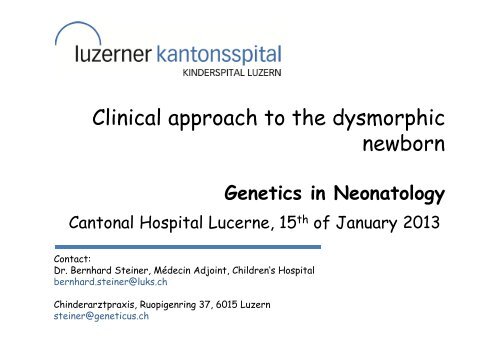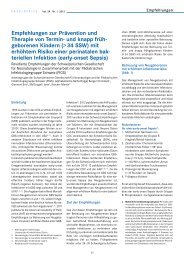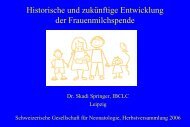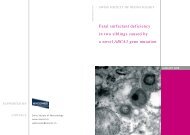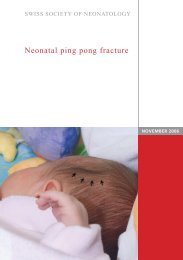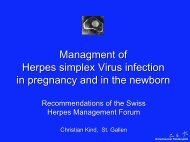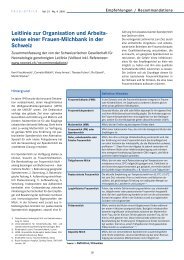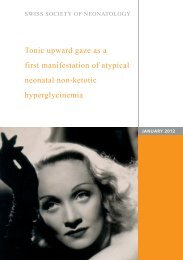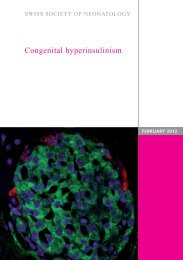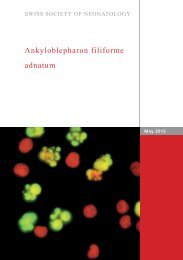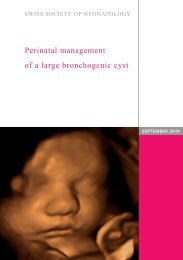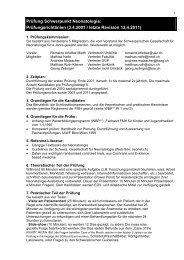Clinical approach to the dysmorphic neonate
Clinical approach to the dysmorphic neonate
Clinical approach to the dysmorphic neonate
You also want an ePaper? Increase the reach of your titles
YUMPU automatically turns print PDFs into web optimized ePapers that Google loves.
<strong>Clinical</strong> <strong>approach</strong> <strong>to</strong> <strong>the</strong> <strong>dysmorphic</strong><br />
Contact:<br />
Dr. Bernhard Steiner, Médecin Adjoint, Children‘s Hospital<br />
bernhard.steiner@luks.ch<br />
Chinderarztpraxis, Ruopigenring 37, 6015 Luzern<br />
steiner@geneticus.ch<br />
newborn<br />
Genetics in Neona<strong>to</strong>logy<br />
Can<strong>to</strong>nal Hospital Lucerne, 15 th of January 2013
Major congenital anomalies<br />
At birth: 2 – 3 %<br />
At age 5: 4 – 6 %<br />
Minor congenital anomalies<br />
At birth: 15 %<br />
<strong>Clinical</strong> <strong>approach</strong> <strong>to</strong> <strong>the</strong> <strong>dysmorphic</strong> newborn
Major malformations.<br />
Major versus minor anomalies<br />
Those that have medical & /or social implications.<br />
Often require surgical repair.<br />
Minor malformations.<br />
Have sometimes cosmetic significance.<br />
Normal variants.<br />
From J. Graham: Smith‘s Recognizable Patterns of Human Deformation (2007)
The importance of minor anomalies<br />
„Minor anomalies“ are indica<strong>to</strong>rs for<br />
relevant „major anomalies“<br />
(malformations of organs, mental<br />
retardation).<br />
• Ultrasound of <strong>the</strong> brain<br />
• Ultrasound of <strong>the</strong> heart<br />
• Ultrasound of <strong>the</strong> abdomen<br />
• Examination of <strong>the</strong> eyes<br />
• Examination of <strong>the</strong> ears<br />
From J. Graham: Smith‘s Recognizable Patterns of Human Deformation (2007)
Causes of human malformations<br />
Cause Percent Incidence<br />
Genetic 15-25<br />
Chromosome 10-15<br />
Single gene 2-10<br />
Multifac<strong>to</strong>rial 20-25<br />
Environmental 8-12<br />
Maternal diseases 6-8<br />
Uterine / plazental 2-3<br />
Drug / chemicals 0.5-1<br />
Twinning 0.5-1<br />
Unknown 40-60<br />
From Stevenson and Hall: Human Malformations And Related Anomalies (2006)
His<strong>to</strong>ry of intrauterine<br />
developement<br />
<strong>Clinical</strong> <strong>approach</strong> <strong>to</strong> <strong>the</strong> <strong>dysmorphic</strong> newborn<br />
Accurate diagnosis<br />
Allow for decision making<br />
and communicating:<br />
Prognosis.<br />
Treatment options.<br />
Occult abnormalities.<br />
Recurrence risk.<br />
Pathogenesis.
Possible tera<strong>to</strong>genic exposures<br />
Results of diagnostic procedures (ultrasound, AC)<br />
Complications (bleeding, fever)<br />
Fetal Movement (time of onset, force)<br />
Amount of amniotic fluid<br />
His<strong>to</strong>ry of intrauterine developement<br />
Weeks of gestation
From Moore and Persaud: The Developing Human (1998)<br />
Timetable of human development
Gestation<br />
Complications of labour<br />
Fetal presentation<br />
Mode of delivery<br />
Neonatal status:<br />
• force, breathing, measurements, seizures<br />
Newborn course:<br />
• feeding, anomalies, complications,<br />
resuscitation<br />
Perinatal information<br />
Pre-natal vs. post-natal onset of developmental problems
Three generation family his<strong>to</strong>ry<br />
Ask for:<br />
• Birth defects<br />
• O<strong>the</strong>r genetic disease<br />
• Multiple miscarriages<br />
• Parental ages and health status<br />
• Consanguinity and geographic origin<br />
Family His<strong>to</strong>ry
The major types of problems in morphogenesis<br />
Malformation Deformation Disruption Dysplasia<br />
From J. Graham: Smith‘s Recognizable Patterns of Human Deformation (2007)
<strong>Clinical</strong> <strong>approach</strong> <strong>to</strong> <strong>the</strong> <strong>dysmorphic</strong> newborn<br />
Malformation<br />
Disruption<br />
Deformation<br />
Interrelationships between malformations,<br />
deformations, and disruptions
Problems in morphogenesis: disruption<br />
Disruptions<br />
Morphological alterations of structures after<br />
formation<br />
Due <strong>to</strong> destructive processes<br />
vascular accidents ⇒ bowel atresias<br />
amnion rupture sequence ⇒ limb defects<br />
Recurrence risk low.
Ionisation (X-Ray, radioactivity)<br />
Hyper<strong>the</strong>rmia<br />
Infections<br />
Tera<strong>to</strong>genic (drugs, alcohol)<br />
Metabolic<br />
Vascular disruption<br />
Amnion rupture sequence<br />
Causes of disruption<br />
From J. Graham: Smith‘s Recognizable Patterns of Human Deformation (2007)
From Moore and Persaud: The Developing Human (1998)<br />
Timetable of human development
Deformations<br />
Due <strong>to</strong> mechanical forces that mold<br />
a part of fetus over a prolonged<br />
period of time<br />
- Clubfeet due <strong>to</strong> compression in<br />
<strong>the</strong> amniotic cavity<br />
- Often involve <strong>the</strong> musculoskeletal<br />
system and may be<br />
reversible postnatally<br />
Problems in morphogenesis: deformation
Breech position<br />
Dolichocephalic deformation of <strong>the</strong> head due<br />
<strong>to</strong> intrauterine breech position.<br />
Trisomy 18
Maternal risk fac<strong>to</strong>rs<br />
Primigravida<br />
Small maternal size<br />
Small uterus<br />
Uterine malformation<br />
Uterine fibromata<br />
Small maternal pelvis<br />
Fetal risk fac<strong>to</strong>rs<br />
Oligohydramnios<br />
Large fetus<br />
Multiple fetuses<br />
Risk fac<strong>to</strong>rs for fetal constraint
The non-random clinical association among deformations<br />
From J. Graham: Smith‘s Recognizable Patterns of Human Deformation (2007)
Deformations related <strong>to</strong> breech presentations<br />
From J. Graham: Smith‘s Recognizable Patterns of Human<br />
Deformation (2007)
Disorders predisposing <strong>to</strong> breech presentation<br />
3% of all births with breech presentations<br />
23% of all newborns with malformations<br />
with breech positions<br />
From J. Graham: Smith‘s Recognizable Patterns of Human<br />
Deformation (2007)
Problems in morphogenesis: malformation<br />
Malformations<br />
Occur during formation of structures<br />
Complete or partial absence<br />
Alterations of its normal configuration<br />
The exact mechanism is mostly<br />
unknown. Error in embryonic cell<br />
proliferation, differentiation,<br />
migration, programmed death and<br />
cell <strong>to</strong> cell communication.<br />
Recurrence risk unknown.
Development of lymphatic system<br />
The early developing lymph channels drain in<strong>to</strong> <strong>the</strong> venous system (approx. 8 week).
Development of lymphatic tissue
Development of lymphatic tissue
Development of lymphatic tissue
Dermal ridges of fingertips and simian crease<br />
From J. Graham: Smith‘s Recognizable Patterns of Human Deformation (2007)
Evaluation of cleft palate
Brain and hair<br />
developement:<br />
13 th and 18 th week<br />
Hair pattern and intrauterine brain growth<br />
From J. Graham: Smith‘s Recognizable Patterns of Human Deformation (2007)
Hair pattern and intrauterine brain growth<br />
Frontal «up-sweep»<br />
or<br />
cow lick
Hair pattern and intrauterine brain growth
Hair pattern and intrauterine brain growth
Systematic clinical evaluation<br />
Anthropometry Height, weight, head circumference, arm span, US/LS ratio<br />
The fur<strong>the</strong>r measurements deviates from <strong>the</strong> normal centile ranges, <strong>the</strong> greater <strong>the</strong><br />
change of making a genetic diagnosis<br />
Head Shape, size, anterior and posterior fontanelle, forehead and temporal region<br />
Hair Colour, texture, hair whorl pattern, hair line, growth<br />
Eyes Slant, intercanthal distance, shape, size, cornea, sclera, iris (colour, coloboma),<br />
fundus<br />
Ears Size, position, shape<br />
Mouth region Size, shape, palate (narrow, high arched, cleft), alveolar ridges, lips (thick, thin, cleft,<br />
shape), Philtrum (small, long, simple, prominent)<br />
Chin & Malar region Micrognathia, retrognathia, hypoplasia of malar region<br />
Neck Short, long, webbed<br />
Chest Shape, inter nipple distance, sternum<br />
Hands & Upper<br />
limbs<br />
Shape, fingers, nails, clinodactyly, limb lengths, carrying angle<br />
Feet & Lower limbs Shape, <strong>to</strong>es, big <strong>to</strong>e abnormalities, sandal gap, limb lengths, hip dislocation, edema<br />
Skin Colour, texture, hirsutism, sweating, pigmentary abnormalities
Where <strong>to</strong> find reference data<br />
Greenwood growth references<br />
– Greenwood genetic center<br />
– http://www.ggc.org
ABase
ABase
Eyes<br />
Slant, inner and outer<br />
canthal distance, shape, size,<br />
cornea, sclera, iris (colour,<br />
coloboma), fundus
Inner canthal distance<br />
Outer canthal distance<br />
Interpupillary distance<br />
Telecanthus, hyper- and hypotelorism
Telecanthus, hyper- and hypotelorism
Size, position, shape<br />
Ear pit!<br />
Ears
Hypoplastic ear<br />
Microtia<br />
Ears
Ears
P P<br />
Ear position / ear rotation<br />
• Ear position<br />
- location of <strong>the</strong> superior attachment of <strong>the</strong> pinna<br />
- measurement<br />
- line through inner and outer canthi<br />
- line between <strong>the</strong> outer canthus and <strong>the</strong> most<br />
prominent part of <strong>the</strong> occiput<br />
• Ear rotation<br />
- rotation of <strong>the</strong> median longitudinal axis of <strong>the</strong> external<br />
auricle<br />
- measurement<br />
- Frankfurt horizontal plane – medial longitudinal axis<br />
of <strong>the</strong> ear, connecting <strong>the</strong> two most remote points<br />
- normal rotation: 17-22 degrees<br />
R
22 o<br />
Ear position / ear rotation
Size<br />
Shape<br />
Palate (narrow, high arched, cleft)<br />
Alveolar ridges,<br />
Lips (thick, thin, cleft, shape)<br />
Philtrum (small, long, simple, prominent)<br />
Mouth
Micrognathia<br />
Retrognathia<br />
Hypoplasia of malar<br />
region<br />
Chin
Short<br />
Long<br />
webbed<br />
Neck
Hand and fingers<br />
Shape, fingers, nails,<br />
clinodactyly, limb lengths,<br />
carrying angle
Sandal gap<br />
Feet
Syndactyly of <strong>to</strong>es<br />
Sign for reduced<br />
intrauterine movements,<br />
but also a frequent<br />
unspecific sign.<br />
Described in 325 different<br />
traits.<br />
Feet
Neurologic examination
Etiology / pathogenesis /phenotype<br />
Pierre-Robin-Sequence<br />
Oligohydramnios Extrinsic mandibular deformation<br />
Neurogenic hypo<strong>to</strong>nia Lack of mandibular exercise<br />
Growth deficiency Intrinsic mandibular hypoplasia<br />
Connective tissue disorder Intrinsic mandibular hypoplasia and failure of<br />
connective tissue penetration across palate
most syndromes are<br />
polytypic<br />
The importance of databases<br />
The diagnostic process in clinical dysmorphology is difficult !<br />
large number of syndromes<br />
low prevalence of<br />
most syndromes<br />
increasing knowledge<br />
in modern genetics<br />
Need for databases <strong>to</strong> collect information about:<br />
summaries of clinical features<br />
family studies of Mendelian disorders<br />
key journal references<br />
information of research progress about gene localisation and locus<br />
identification
MIM<br />
since 1966<br />
OMIM<br />
since 1985<br />
The importance of MIM and OMIM<br />
McKusick, V.A. Mendelian Inheritance in Man and its online version, OMIM. Am J Hum Genet 80, 588-604 (2007).
Online “expert” systems with free access<br />
Orphanet.<br />
www.orpha.net<br />
Syndroc.<br />
www.syndroc.ch<br />
The Phenomizer.<br />
http://compbio.charite.de/phenomizer
Commercial “expert” systems<br />
London Medical Databases, Winter–Baraitser<br />
Dysmorphology Database.<br />
www.lmdatabases.com<br />
POSSUMweb.<br />
www.possum.net.au<br />
SynDiag.<br />
members.tripod.com/~kolosov
<strong>Clinical</strong> <strong>approach</strong> <strong>to</strong> <strong>the</strong> <strong>dysmorphic</strong> newborn
Thank you for your attention!


